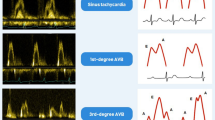Summary
The problem of anginalike chest pain with normal coronary arteriographic findings is briefly reviewed. This common clinical presentation (ca.20% of patients investigated by coronary arteriography) is usually due to noncardiac causes (e.g., thoracic root or esophageal pain) but may represent myocardial ischemia attributable to reduced coronary dilator capacity downstream from the epicardial vessels and of unknown pathogenesis—Syndrome X(?<0.1% of such patients).
Similar content being viewed by others
References
Kemp HG. Left ventricular function in patients with the anginal syndrome and normal coronary arteriograms. Am J Cardiol 1973;32:375–276.
Arbogast R, Bourassa MG. Myocardial function during atrial pacing in patients with angina pectoris and normal coronary arteriograms. Am J Cardiol 1973;32:257–263.
Likoff W, Segal BL, Kasparian H. Paradox of normal selective coronary arteriograms in patients considered to have unmistakable coronary heart disease. N Engl J Med 1967; 276:1063–1066.
Anon. Syndrome X (editorial). Lancet 1987;2:1247–1248.
DartA M, Alban-Davies J, Ruttley M, et al. ‘Angina’ and normal coronary arteriogram: A follow-up study. Eur Heart J 1980:1:97–98.
Dart AM, Alban-Davies H, Griffith T, et al. Does it help to undiagnose angina? Eur Heart J 1983;4:461–462.
Korhola O, Valle M, Frick MH, et al. Regional myocardial perfusion abnormalities on xenon-133 imaging in patients with angina pectoris and normal coronary arteries. Am J Cardiol 1977;39:355–359.
Opherk D, Zebe H, Weibe E, et al. Reduced coronary dilatory capacity and ultrastructural changes of the myocardial in patients with angina pectoris but normal coronary arteriograms. Circulation 1981;63:817–825.
Opherk D, Mall G, Zebe H, et al. Reduction of coronary reserve: A mechanism for angina pectoris in patients with arterial hypertension and normal coronary arteries. Circulation 1984;69:1–7.
Cannon RO, Leon MB, Watson RM, et al. Chest pain and “normal” coronary arteries—role of small coronary arteries. Am J Cardiol 1985;55:50B-60B.
Cannon RO, Schenke WH, Leon MB, et al. Limited coronary flow reserve after dipyridamole in patients in ergonovine-induced coronary vasoconstriction. Circulation 1987;75:163–174.
Boudoulas H, Cobb TC, Leighton RF, et al. Myocardial lactate production in patients with angina-like chest pain and angiographically normal coronary arteries and left ventricle. Am J Cardiol 1974;34:501–505.
Berger HJ, Sands MJ, Davies RA, et al. Exercise left ventricular performance in patients with chest pain, ischemic-appearing exercise electrocardiograms, and angiographically normal coronary arteries. Ann Intern Med 1981;94:186–191.
Schofield PM, Brooks NH, Bennett DH. Left ventricular dysfunction in patients with angina pectoris and normal coronary angiograms. Br Heart J 1985;56:327–333.
Wieshammer S, Delagardelle C, Sigel HA, et al. Haemodynamic response to exercise in patients with chest pain and normal coronary angiograms. Eur Heart J 1986;7:654–661.
Richardson PJ, Livesley B, Oram S, et al. Angina pectoris with normal coronary arteries transvenous myocardial biopsy in diagnosis. Lancet 1974;2:677–680.
Mosseri M, Yarom R, Gotsman MS, et al. Histologic evidence for small-vessel coronary artery disease in patients with angina pectoris and potent large coronary arteries. Circulation 1986;74:364–372.
Griffith TM, Edwards DH, Davies RLI, et al. EDRF coordinates the behaviour of resistance vessels. Nature 1987; 329:442–445.
Factor SM, Sonnenblick EH. The pathogenesis of clinical and experimental congestive cardiomyopathies: Recent concepts. Prog Cardiovasc Dis 1985;27:395–420.
Maron BJ, Wolfson JK, Epstein SE, et al. Intramural (“small vessle”) coronary artery disease in hypertrophic cardiomyopathy. J Am Coll Cardiol 1986;8:545–547.
Opherk D, Schwarz F, Mall G, et al. Coronary dilatory capacity in idiopathic dilated cardiomyopathy: Analysis of 16 patients. Am J Cardiol 1983;51:1657–1662.
Pasternac A, Noble J, Streulens Y, et al. Pathophysiology of chest pain in patients with cardiomyopathies and normal coronary arteries. Circulation 1982;65:778–789.
Kemp HG, Kronmal RA, Vlietstra RE, et al. Seven year survival of patients with normal or near normal coronary arteriograms: A CASS registry study. J Am Coll Cardiol 1986;7:479–483.
Erikssen J, Dale J, Rootwelt K. False suspicion of coronary heart disease: A 7 year follow-up study of 36 apparently healthy middle-aged men. Circulation 1983;68:490–497.
Kubler W, Opherk D. Angina pectoris with normal coronary arteries. Acta Med Scand 1984;694:55–57.
Crake T, Crean PA, Shapiro L, et al. Continuous recording of coronary sinus oxygen saturation during atrial pacing in patients with coronary artery disease or with Syndrome X. Br Heart J in press.
Sax FL, Cannon RO, Hanson C, et al. Impaired forearm vasodilator reserve in patients with microvascular angina. N Engl J Med 1987;317:1366–1370.
Author information
Authors and Affiliations
Rights and permissions
About this article
Cite this article
Henderson, A.H. Syndrome X. Cardiovasc Drug Ther 3 (Suppl 1), 271–274 (1989). https://doi.org/10.1007/BF00148471
Issue Date:
DOI: https://doi.org/10.1007/BF00148471




